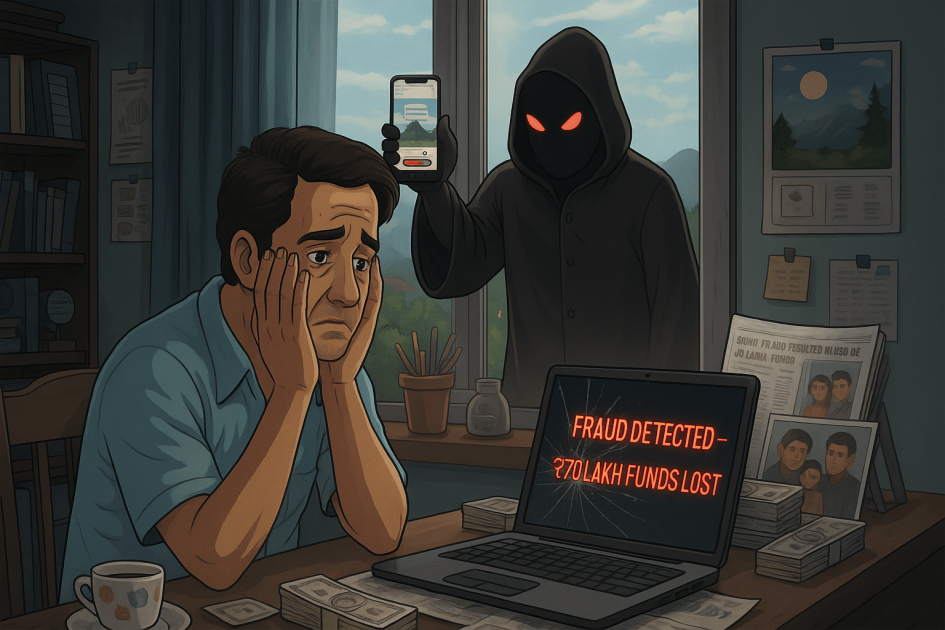What would you do if someone called you, claimed you were linked to a terror attack, and said the police were on their way to arrest you?
For one Mumbai businessman, this terrifying scenario turned into a nightmare. Over two days, he ended up transferring ₹70 lakh to accounts he believed were “safe” — only to realize it was a digital arrest scam built around the Pahalgam terror attack.
This isn’t a simple phishing trick. Scammers are now using real national security incidents to make their fraud look authentic. Let’s break down how this scam worked, why people fall for it, and how you can protect yourself.
How the Pahalgam Attack Became the Perfect Bait?
The Pahalgam terror attack recently dominated headlines across India. Scammers saw an opportunity, a way to weave their story around a real incident so it would sound convincing.
It started with a call from someone pretending to be from a well-known courier company. The caller said a suspicious parcel addressed to the businessman had been intercepted in Pahalgam.
The parcel, they claimed, contained illegal materials linked to terror funding.
Within minutes, the call was “transferred” to officers claiming to be from the Mumbai Cyber Crime Cell and the Narcotics Control Bureau (NCB).
Their tone was serious. Their language was official. And their story was airtight.
“Your identity has been used in a terror financing case. You need to cooperate immediately or face arrest.”
This is where the fear set in. And that’s exactly what the scammers were counting on.
How the Digital Arrest Scam Played Out?
This scam followed a chillingly organized sequence. Here’s how it unfolded:
Step 1: The Courier Call
The first call hooked the victim with a believable story, a parcel linked to Pahalgam. The location and timing made it hard to dismiss.
Step 2: Fake Officials Take Over
The call was then handed to “cybercrime officers.” They shared fake ID cards, quoted case numbers, and spoke with authority. Everything looked and sounded official.
Step 3: The Zoom Call Trap
The businessman was then connected to a Zoom video call. On the screen were people in uniforms, sitting in what appeared to be a government office. They claimed he was being put under “digital arrest” — a term meant to terrify.
Step 4: Psychological Control
Once the video call started, the scammers issued strict instructions:
- He must stay on video until the case is “resolved.”
- He cannot speak to anyone, not even family.
- If he disconnected, he’d be arrested immediately.
In that moment of fear and isolation, logic goes out the window.
Step 5: Draining the Bank Account
The fake officials then told him his bank accounts were compromised.
To “prove his innocence,” he had to transfer all his funds to “safe government accounts.”
Under pressure, he transferred ₹70 lakh in multiple transactions over two days.
Step 6: Silence
Once the money was gone, the scammers vanished. Calls stopped. Video links were cut. That’s when the realization hit — he’d been trapped.
Why People Fall for Digital Arrest Scams?
It’s easy to assume this could never happen to you. But digital arrest scams work precisely because they target your emotions, not your intelligence.
Here’s why victims comply:
- They use real incidents (like the Pahalgam attack) to build trust.
- They impersonate authority flawlessly — fake IDs, official-looking Zoom backgrounds, uniforms.
- They isolate the victim, cutting them off from friends or legal help.
- They create urgency — “cooperate now or get arrested.”
- People don’t know the protocol — many aren’t aware that real police never arrest people on video or ask for money.
Even educated professionals and business owners have fallen for these scams. The mix of fear and official-looking communication is powerful.
How to Identify a Digital Arrest Scam?
The best way to avoid becoming the next victim of a digital arrest like in the above-mentioned Pahalgam attack scam is to spot the red flags early. Here’s what to watch for:
- Calls from unknown courier services about suspicious parcels.
- Threats linking you to terrorism or illegal activities.
- Orders to join video calls with uniformed people claiming to be officers.
- Demands to transfer money to “safe government accounts.”
- Instructions to stay isolated or not speak to anyone.
- No official documents or notices were provided through proper channels.
Important: No law enforcement agency in India will ever:
- Arrest you over a video call, or
- Ask for money transfers to clear your name.
The moment you hear these demands, treat them as a scam.
How to Report Digital Arrest Scams?
If you ever receive a call like this, or if someone you know is being targeted, act quickly. Every minute counts.
- File a complaint in Cyber Crime:
Document every proof, call records, and report the case in cybercrime online. - Alert Your Bank:
Inform your bank to block or recall suspicious transactions right away. - File an FIR:
Lodge a police complaint at your nearest station with all details — calls, video chats, transaction slips. - Keep Evidence:
Save call recordings, screenshots, bank messages, Zoom call details — anything that can help the investigation.
Need Help?
If you’ve been targeted by a digital arrest scam or any other online scams like, investment scams, fake forex investment scams, work from home scams, then register with us to report and start the recovery process.
Conclusion
The Pahalgam attack scam is part of a growing trend of digital arrest scams in India. Cybercriminals are no longer relying on clumsy emails.
They’re using real incidents, legal jargon, and psychological tactics to corner their victims.
The Mumbai businessman’s case isn’t rare, and that’s what makes it dangerous.
These scams are evolving fast. Awareness is your strongest defense.
If you ever receive such a call, don’t panic. Hang up.
Verify through official channels. Talk to someone you trust. And never transfer money under pressure.







